

Solarham. Cosmigraphics: Picturing Space Through Time in 4,000 Years of Mapping the Universe. Long before Galileo pioneered the telescope, antagonizing the church and unleashing a “hummingbird effect” of innovation, humanity had been busy cataloging the heavens through millennia of imaginative speculative maps of the cosmos.

We have always sought to make visible the invisible forces we long to understand, the mercy and miracle of existence, and nothing beckons to us with more intense allure than the majesty and mystery of the universe. Four millennia of that mesmerism-made-visible is what journalist, photographer, and astrovisualization scholar Michael Benson explores with great dedication and discernment in Cosmigraphics: Picturing Space Through Time (public library) — a pictorial catalog of our quest to order the cosmos and grasp our place in it, a sensemaking process defined by what Benson aptly calls our “gradually dawning, forever incomplete situational awareness.” Contemporary thought is endangered by the picture of nature drawn by science. Cottam et al., Accretion Disk Corona Source 4U 1822-37. The Astrophysical Journal, 557:L101-L104, 2001 August 20 © 2001.
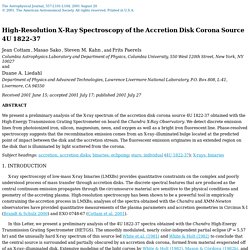
The American Astronomical Society. All rights reserved. Corso I - Il Corpo Nero. Cowley et al., V691 CrA. THE ASTRONOMICAL JOURNAL, 125:2163-2172, 2003 April © 2003.
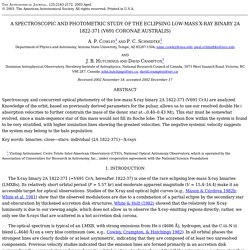
The American Astronomical Society. All rights reserved. Printed in U.S.A. A. DOPPLER BOOSTING IN KEPLER LIGHT CURVES. We retrieved the light curves of KOI 74 and KOI 81 from the archive, and show the raw aperture fluxes in Figure?

1. For both sources, one sees the eclipses and transits superposed on roughly quadratic trends; in KOI 81, one also sees the pulsations reported by R10. We first review what one can infer from the transits and eclipses, and then discuss additional information seen at other phases. Figure 1 Plasma astrophysics How to see a black hole Nature Physics. Astronomia nei raggi X. Astronomy 498. Belajar Astronomy May 2009. Looking through a telescope at the stars there is very little information we can gain from them.

To be sure, we know what color they are and we can see that some are more luminous than others. If we use a spectrograph we can tell what elements they are made up from. From these facts alone, it is difficult to tell just how much mass they contain. Alberio (Visual Binary) Visual Binaries are stars that are clearly gravitational associated with one another. Optical Doubles are stars that appear to lie close together, but in fact do not, they only appear to us from our earthly observation to be close together. William Herschel began looking for optical doubles in 1782 with the hope that he would find a measurable parallax, by comparing a close star to the more distant star in an optical double.Herschel did not find any optical binaries, but he did catalog hundreds of visual binaries. Spectroscopic BinaryIt is also possible to detect binary stars using a spectroscope. Iopscience.iop.org-0004-637X-557-1-24-53545.text.html. The Astrophysical Journal, 557:24-29, 2001 August 10 © 2001.
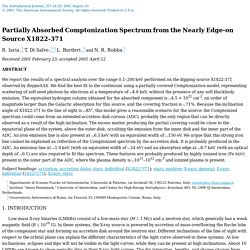
The American Astronomical Society. All rights reserved. Www.mpe.mpg.de-~am-flares.html. Accretion disc coronae and magnetic flares Introduction The hard X-ray power law component in BHC and Seyfert galaxies spectra is most likely due to multiple Compton scattering (Comptonization) of soft photons on a population of hot electrons which reside in a region surrounding the accretion disc itself.
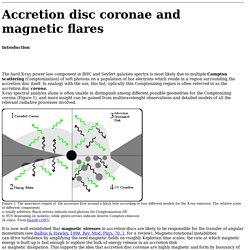
In analogy with the sun, this hot, optically thin Comptonizing region is often referred to as the accretion disc corona.X-ray spectral analysis alone is often unable to distinguish among different possible geometries for the Comptonizing corona (Figure 1), and more insight can be gained from multiwavelenght observations and detailed models of all the relevant radiative processes involved. Figure 1: The innermost region of the accretion flow around a black hole according to four different models for the X-ray emission. The Fundamentals of Stellar Astrophysics (by G.W. Collins II) Web Edition by G.W.

The Plasma Beta - Theory of Black Hole Accretion Discs - Google Libri#v=onepage&q&f=false. Thesis Database. Time delay. The Astrophysical Journal, 521:L45-L48, 1999 August 10 © 1999.

The American Astronomical Society. USGS Isis Isis 2 User Documentation. Gravitational redshift. Niel Brandt's Astronomy 485 Lectures. Lecture 01: Photons and Particles, Units, Early X-ray Astronomy History, X-ray Absorption Audio recording (mp3)Overhead 01 (jpg) - X-ray spectrum of the Circinus Galaxy from the ASCA satelliteOverhead 02 (jpg) - The Milky Way surveyed with rocket-borne proportional countersOverhead 03 (jpg) - Atmospheric transmission as a function of wavelengthOverhead 04 (jpg) - Relative abundances of the elements Lecture 02: X-ray Absorption, Column Density, Absorption Edges, Fluorescent Lines, Auger Effect Lecture 03: Radiation from a Hot Plasma, Bremsstrahlung.
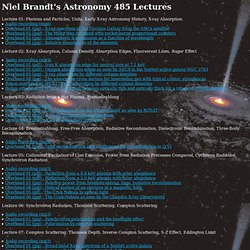
PhD Thesis Database. Laboratorio di Astrofisica II. Le righe spettrali, Composizione chimica, Classificazione spettrale, Misure di velocita', Esempi di fattibilita' Le righe spettrali Vediamo brevemente come si formano le righe nell'atmosfera di una stella. HEASARC Data Archive. HEASARC Browse Main Interface. Paolo Nespoli (astro_paolo) on Twitter. L'astrofisica è facile - Mike Inglis - Google Libri. Lecture 7 Opacity. Lezione n.6: La distribuzione di Boltzmann e l'equazione di Saha Per conoscere quali sono le righe che si formaranno, è necessario conoscere qual è lo stato di ionizzazione della materia, e come saranno popolati i diversi stati eccitati (a differenti livelli di energia); a questa seconda domanda risponde equazione di Boltzmann: Qui NA e NB sono i numeri di densità degli atomi negli stati A e B, EA e EB le energie degli stati, gA e gB i pesi statistici dei livelli (per esempio il numero degli stati permessi a quel livello di energia).
Lecture 29 The Earth's Atmosphere. Key Ideas: Composition:Nitrogen, Oxygen, Argon & Water Vapor Lack of Hydrogen or Helium Greenhouse Effect: Explains why the Earth is as warm as it is. Structure of the Atmosphere. Lecture 15 Stellar Atmospheres, Variable Stars. Lecture 15: Stellar Atmospheres, Variable Stars Stellar Atmospheres: How the layers above the photosphere affect a star's spectrum What controls the widths and strengths of spectral lines? What is observed: The "strength" of a spectral line is the area of the spectral line in a wavelength versus intensity plot -- often expressed as "equivalent width". To understand what effects the width and strength of a line, remember what causes a spectral line: individual atoms or molecules containing electrons that change orbits.
Mario A. Jimenez. I am an X-ray astrophysicist. I am interested in a mixture of experimental development work (X-ray optics for telescopes), observations with X-ray telescopes (X-ray spectroscopy of compact objects), and theory (numerical modeling of accretion disks around neutron stars and black holes). Here is a quick list of my interests: "Atomic X-ray Spectra of Accretion Disk Atmospheres around Kerr Black Holes," Jimenez-Garate, M.A., Raymond, J. C., Mauche, C. W., Liedahl, D., ApJ 2005 submitted. Modified Julian Day Converter. This converter requires the use of Javascript enabled and capable browsers. There are two converters in this script, the first converting from MJD to MM-DD-YYYY in the modern Gregorian calendar format. The second converts from the MM-DD-YYYY format to the MJD number. This converter is accurate from 1754 A.D. to current date. All entries are numeric; in the case of months, it is MM, with the MM being from 01 to 12.
ON THE NATURE OF THE COMPACT OBJECT IN SS 433. We derive a lower limit of 2 solar masses for the compact object in SS? 4333 which clearly does not rule out a neutron star? This limit alone does not give strong observational evidence for a BH. This is the lower limit of the central object mass obtained using the sliding index? Parameter of ionization - Positions and identifications for galactic X-ray sources 2A1822−371 and 2S1254−690. Scattering in the inner accretion disk and the waveforms and polarization of millisecond flux oscillations in LMXBs. Scattering in the inner accretion disk and the waveforms and polarization of millisecond flux oscillations in LMXBs S. Gravitation and Cosmology Principles and Applications of the General Theory of Relativity - Free eBooks Download.
Steven Weinberg, "Gravitation and Cosmology: Principles and Applications of the General Theory of Relativity" W..ey | 1972 | ISBN: 0471925675 | 657 pages | Djvu | 5,4 mb. M. T. Home page. Home Page for Shude Mao. Photoelectric Effect - The Physics Hypertextbook. Dilemma Under the right circumstances light can be used to push electrons, freeing them from the surface of a solid. This process is called the photoelectric effect (or photoelectric emission or photoemission), a material that can exhibit this phenomena is said to be photoemissive, and the ejected electrons are called photoelectrons; but there is nothing that would distinguish them from other electrons. All electrons are identical to one another in mass, charge, spin, and magnetic moment.
P_Physics-PAp_Astrophysics. SIMBAD X1822-371. STUDIARE ASTROFISICA OGGI E IL LAVORO DELL'ASTRONOMO. Spectral index. In astronomy, the spectral index of a source is a measure of the dependence of radiative flux density on frequency. Given frequency and radiative flux , the spectral index is given implicitly by Note that if flux does not follow a power law in frequency, the spectral index itself is a function of frequency. Spettroscopia Solare. La cromosfera ha uno spessore di circa 10.000 km e la sua parte più interna, ossia quella più vicina alla fotosfera è detta "strato invertente", in quanto l' osservazione dello spettro di questa porzione della nostra stella, in occasione di eclissi, presenta, per un brevissimo istante, le righe di Fraunhofer in emissione anziché in assorbimento; quello che si registra è lo spettro del gas dell' atmosfera solare, privo dello sfondo della fotosfera ed è chiamato "spettro lampo".
Spettro del Sole. Spettro del Sole con il filtro Star Analyser 100. L'economico Star Analyser 100 e' usato normalmente per rilevare spettri stellari. SIMBAD query result. Gruppo di Astrofisica delle Alte Energie - Università di Cagliari - Home. Spettroscopia di emissione atomica - Wikipedia. Spettroscopia X di corone stellari. Cfa.harvard.edu. American Association of Variable Star Observers.
Coronae. Corona - Wikipedia, the free encyclopedia. Comparison of EXOSAT light curves of 2A 1822-371 and EXO 0748-676. Chinese constellations - Wikipedia, the free encyclopedia. Casares et al., Bowen Fluorescence in X1822-371. Blackbody Radiation&photoeletric effect. BinSim Downloads. Atomic spectral line - Wikipedia, the free encyclopedia. Astronomy Knowledge Base. Astronomia nei raggi X. Chandra Field Guide to X-ray Astronomy X-Ray Absorption.
Xspector. Lecture 8 Supplement Stellar Spectral Types. Spiff.rit.edu-classes-phys440-lectures-curve-curve.html. Www.lorenzoroi.net-prelievi-SintesiDistribuzioni.pdf. Www.df.unipi.it-~paolic-dispense.html. Table A.2 2XMM observations and their targets. The observation and analysis of ... - Google Libri. Advances in Computational Astrophysics methods, tools and outcomes Cefalù (Sicily, Italy) June 13-17, 2011. Absorption and Emission Spectra. An Atlas of Stellar Spectra. Interpreting Stellar Spectra. The Indo-U.S. Library of Coudé Feed Stellar Spectra. Giallo's PHD Thesis. Laboratorio di Astrofisica II. Dale E. Gary, Personal Page. Astrofisica Stellare Capitolo 3. Public Education and Outreach. ASCOM - Standards for Astronomy. ADS Virtual library (Books) Heasarc NASA's X-ray & Gamma-ray Astronomy Data Archive. CCD University - in italiano. Heasarc WebPIMMS Help.
Variability of Active Galactic Nuclei - B.M. Peterson. Atomdb Features Density Diagnostics. Why are X-rays absorbed in the atmosphere. XRONOS User's Guide. X-ray Absorption Edges. Integral-table. X-Ray Astronomy 2 X-ray Binaries. X-ray spectroscopy in astrophysics ... - Google Libri. Xte.mit.edu-asmlc-srcs-x1822-371.html. Apod 2005 July 12 - Launch of the Red Bird. ASTRONOMIA. Absorption Spectra. Susan Lea. Pixel Binning - ita. Pixel binning.